When you think about leather boots, you probably think about expensive designer boots meant for wealthy people. However, you may not know that there is a way to recondition your old leather boots to look and feel like new again. In this article, we will discuss how to recondition leather boots. We will also provide tips on properly caring for your leather boots to keep them looking good for years to come. So, if you want to learn how to recondition your old leather boots, read on!
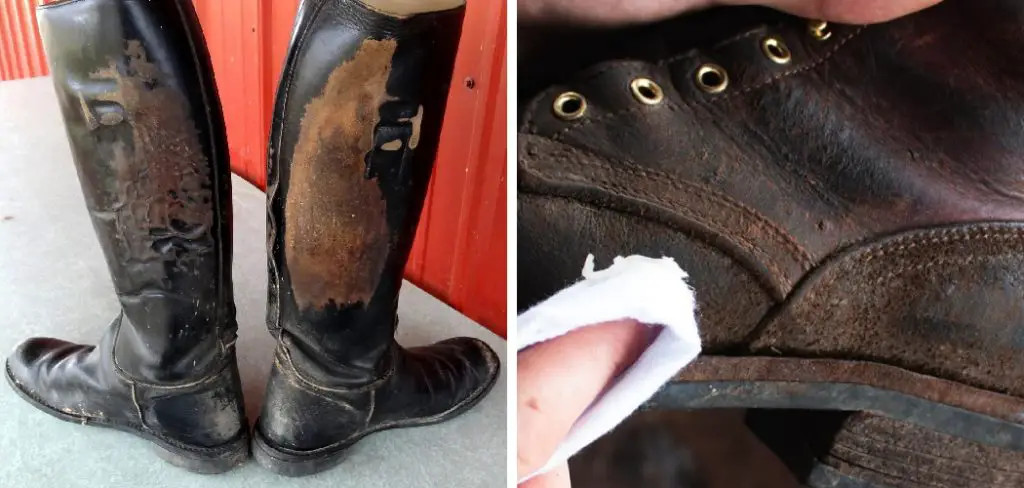
Leather boots are a popular choice for many people because they are durable and stylish. However, over time, leather boots can become dry and cracked. If you want to keep your leather boots looking new, it is essential to recondition them regularly. It is also necessary to properly care for your leather boots.
Summary: To recondition leather boots, first, wipe off any dirt or debris using a damp cloth. Next, apply a leather cleaner to remove any stains or discolorations. Then, apply a leather conditioner to restore moisture and suppleness to the leather. Allow the conditioner to soak in for a few hours or overnight. Finally, buff the boots with a soft cloth to remove any excess conditioner and restore shine.
A Detailed Guide on How to Recondition Leather Boots
Step 1: Determine if Your Leather Boots Need to Be Reconditioned
If your leather boots are starting to show signs of wear and tear, it may be time to consider reconditioning them. This process involves treating the leather with a conditioning product that will help restore its softness and flexibility and remove any dirt or stains that may have accumulated over time.
There are a few ways to tell if your leather boots need to be reconditioned. For example, if they feel stiff or brittle when you flex them, this is often an indication that they could benefit from some TLC. Additionally, if you notice any unsightly marks or blemishes on the surface of the leather, these can usually be removed using a specialized cleaner or conditioner.
If you’re not sure whether or not your leather boots need to be reconditioned, it’s always best to err on the side of caution and give them a treatment anyway. This will help ensure that they remain in good condition for many years to come.
Step 2: Remove Lace and Place Leather Boots in a Clean Area
Once you’ve determined that your leather boots need to be reconditioned, the next step is to remove any laces or other accessories from them. This will make it easier to apply the conditioning product evenly and minimize the risk of getting dirt or debris on the surface of the leather.
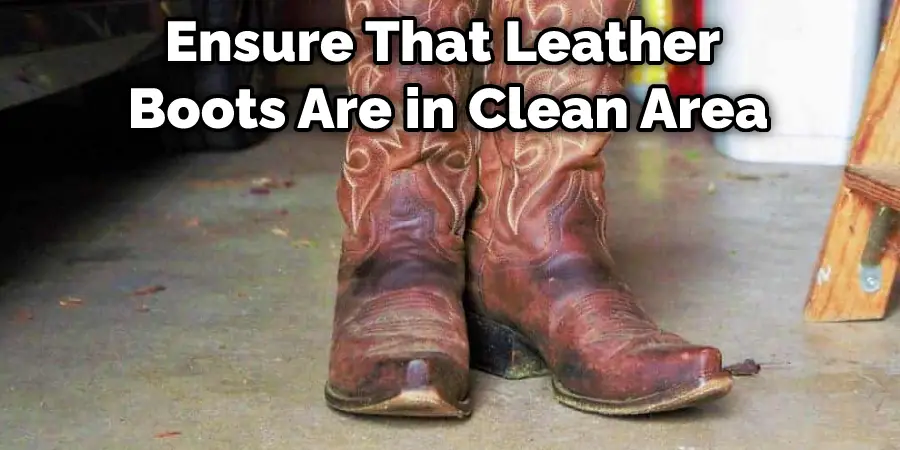
To ensure that your leather boots are in a clean area while they are being reconditioned, it’s best to place them on a flat, dry surface protected by an old towel or cloth. You can then use this space as your workspace for the rest of the process.
Step 3: Clean Your Leather Boots
If you own a pair of leather boots, it’s essential to take good care of them to keep them looking and feeling great. One of the best ways to recondition your leather boots is by cleaning them regularly.
First, start by removing any dirt or debris from your boots using a soft brush or damp cloth. Next, fill a small bowl with warm water and add a small amount of mild soap or leather cleaner. Finally, gently dip a soft cloth into the mixture and use it to wipe down your leather boots gently. Be sure to focus on hard-to-reach areas like the creases and seams.
Step 4: Get Creases Out of Your Leather Boots
If your leather boots have deep creases or wrinkles, there are a few different techniques you can try to get them looking new again. One option is to gently rub the surface of the leather with a soft cloth that has been dipped in warm water. Then, after letting the boots dry entirely overnight, use a blow dryer on low heat to help soften any stubborn creases.
Another method for smoothing out creases and wrinkles is placing your leather boots in a plastic bag and several ice cubes. Seal up the bag tightly and leave it overnight. The following day, carefully remove your boot from the bag and wipe down its surface with a damp cloth or sponge until all excess moisture has been removed.
Step 5: Apply Leather Cream or Conditioner
Once your leather boots have been cleaned, and any creases or wrinkles have been removed, it’s time to apply a leather cream or conditioner. This will help restore the natural oils in the leather, making it softer and more flexible.
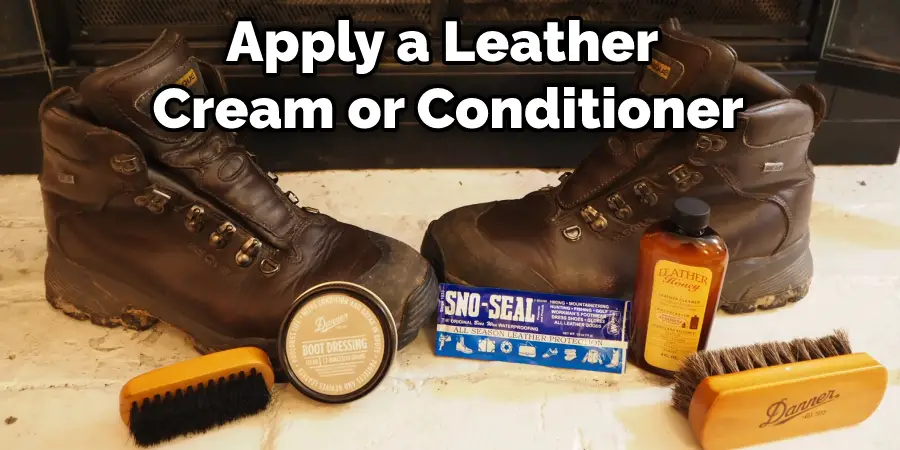
When applying the cream or conditioner, be sure to use a small amount and work it into the surface of the leather using circular motions. Once you’ve evenly applied the product, let it sit for 10-15 minutes before wiping away any excess with a clean cloth.
Step 6: Polish Your Leather Boots
After conditioning your leather boots, you may also want to give them excellent polish. This will help protect the surface of the leather and make it shine.
There are various polishes that you can use, but it’s best to choose one that is specifically designed for leather. Start by applying a small amount of polish to a soft cloth and then rub it into the boot’s surface in small circles. Once you’ve evenly coated the entire boot, use a clean cloth to buff it until it has a nice shine.
Step 7: Let Your Leather Boots Dry
After you’ve reconditioned your leather boots, it’s essential to let them dry completely before wearing them again. The best way is to place them in a well-ventilated area out of direct sunlight. Then, allow them to sit for 24 hours so that the conditioner or cream has time to absorb into the leather fully.
Step 8: Buff Your Leather Boots
Once your leather boots have been reconditioned and dried, it’s essential to give them a final buffing. This will help remove any excess conditioner or polish from the surface of the leather, leaving your boots looking clean and shiny.
To do this, use a soft cloth or horsehair brush to gently buff the boot’s surface until all residue has been removed. Be sure to check for any remaining stains or marks before wearing your shoes again. With regular care and reconditioning, you can keep your leather boots looking great.
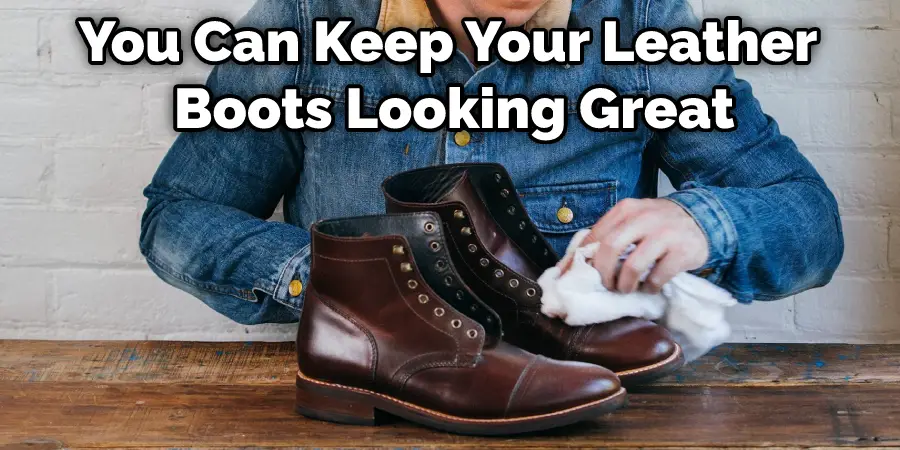
Tips
Whether you’re trying to recondition worn leather boots or restore a pair that’s seen better days, there are some critical steps to achieve the best results. Here are a few tips to keep in mind:
- Start by cleaning your boots thoroughly with a damp cloth and a mild soap. Be sure not to use any harsh chemicals, as these can damage the material of your shoes over time.
- Once your boots are clean and dry, apply a leather conditioner or moisturizer designed explicitly for restoring leather garments and footwear. This will help rejuvenate the material, so it looks soft and supple again.
- If you notice any scuffs or scratches on your boots, you can try using a leather repair kit to fill them in and make them less visible.
- Finally, if your boots are extremely dry or cracked, you may need to apply a leather sealant before conditioning them. This will help create a barrier that will prevent further damage from occurring.
By following these tips, you can keep your leather boots looking new for many years!
Properly Care for Your Leather Boots
Fall is finally here, which means it’s time to break out the leather boots! While leather boots are a stylish and functional wardrobe staple, they require some special care to keep them looking their best. Here’s how to recondition your leather boots and keep them looking great season after season.
- Clean your boots regularly. Grit and dirt can damage the leather, so it’s essential to clean your shoes often. You can use a soft cloth or brush to remove dirt or debris.
- Condition the leather. Just like your skin, leather needs to be moisturized to stay healthy. Use a quality leather conditioner every few weeks to keep the leather soft and supple.
- Invest in a good waterproofing product. Even if you take good care of your leather boots, they are likely to get wet. So apply a quality waterproofing product regularly to prevent water damage and keep your boots looking great.
- Store your boots properly when not in use. Leather is naturally porous, so storing your boots in a cool, dry place away from direct sunlight and humidity is essential. A simple boot box or shoe bag can help protect them from dust and dirt while not being worn.
By following these simple tips, you can ensure that your leather boots look beautiful season after season. So go ahead and treat yourself to those gorgeous new boots – with proper care, you’ll be able to enjoy them for years to come!
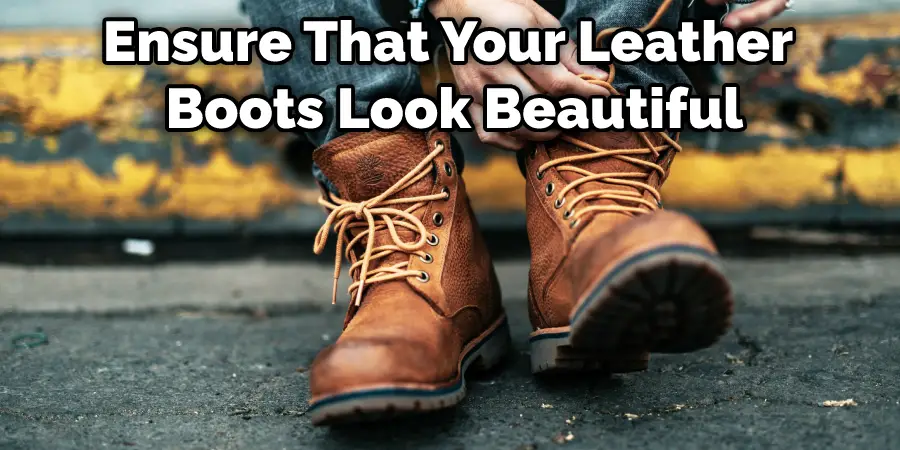
Frequently Asked Questions
What Household Items Can Restore Leather?
Milk, lemon juice, and vinegar. All of these items contain acids that can help break down the glue that holds the leather together. Once the glue is broken down, the leather can be restored by using a solvent to remove the remaining glue.
Is Vaseline Good for Leather Boots?
Vaseline is not good for leather boots because it can damage the finish. In fact, if your boots are still in good condition but have a Vaseline residue on them, you should wash them with soap and water as soon as possible to remove the oil.
What Home Remedy Can I Use to Restore Leather?
Olive oil, butter, lard or duck fat, neatsfoot oil, and castor oil. Each of these oils has unique properties that can help in restoring leather. For example, olive oil is renowned for its antioxidant and anti-inflammatory properties which make it ideal for healing damaged skin cells and promoting restoration of existing collagen. Butter is also beneficial because it contains natural antimicrobial agents that fight against bacteria and fungus responsible for damage to surface proteins within the animal’s skin. Lard or duck fat helps improve texture by helping to repel water while staying soft enough so as not to cause irritation. Neatsfoot oil has been traditionally used as a remedy for dryness and cracking due to environmental exposure or aging (similarly to petroleum jelly).
Conclusion
Reconditioning your leather boots is a great way to keep them looking and feeling new. It’s also a relatively straightforward process requiring a few simple tools and supplies. In this article, we outlined how to recondition leather boots. So whether your boots are starting to look a little tired or you want to give them some extra protection against the elements, follow along with these steps, and they’ll be good as new in no time!
You May Also Read: How to Refinish Leather Boots

